Effective community building in Stronghold hinges on resource management and defense strategies. Collaborating on resource allocation fosters trust and unity among members. A strong defense safeguards these resources, promoting stability and resilience. Technology enhances these practices, streamlining communication and improving decision-making for sustainable growth.
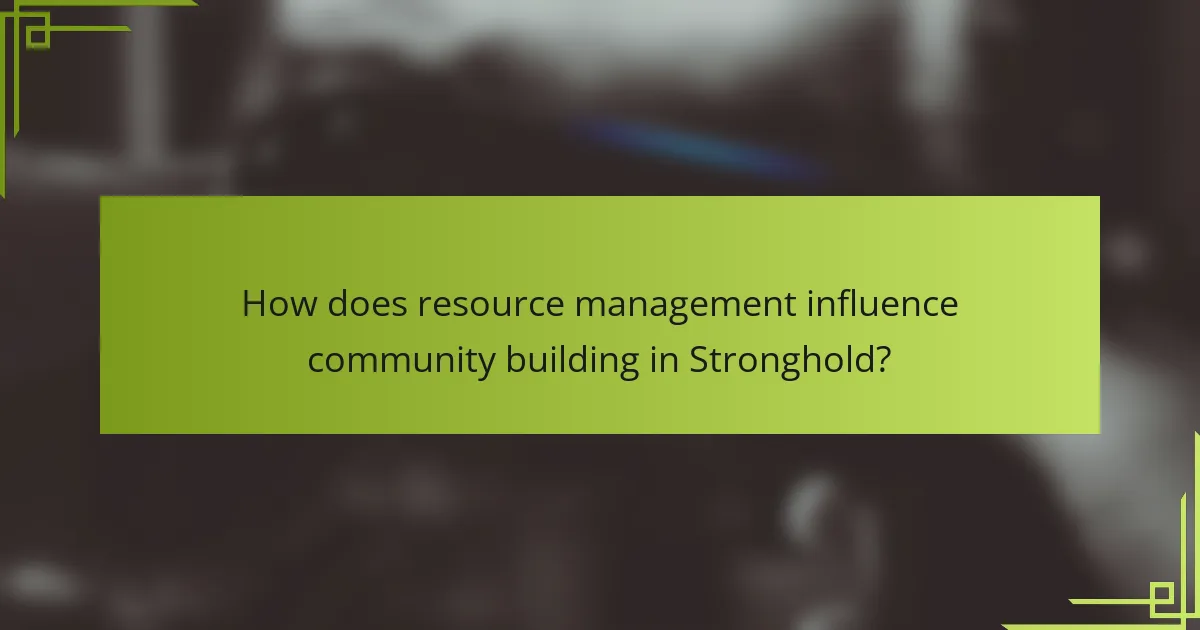
How does resource management influence community building in Stronghold?
Resource management significantly enhances community building in Stronghold by fostering collaboration and defense strategies. Effective allocation of resources enables players to support one another, share supplies, and strengthen their defenses against threats. This cooperative approach builds trust and unity among community members. Additionally, managing resources efficiently leads to sustainable growth, allowing communities to thrive and adapt to challenges. Ultimately, resource management serves as the backbone of a resilient and engaged community in Stronghold.
What are the key resources needed for effective community development?
Effective community development requires key resources such as financial support, skilled personnel, and strong partnerships. Financial resources enable project funding and sustainability. Skilled personnel bring essential expertise and leadership. Strong partnerships foster collaboration and resource sharing. These elements collectively enhance community resilience and growth.
Which strategies enhance resource allocation and sustainability?
Effective strategies for enhancing resource allocation and sustainability include community engagement, efficient resource tracking, and adaptive management. Community involvement fosters collaboration, ensuring that resources meet local needs. Efficient tracking of resources minimizes waste and optimizes usage. Adaptive management allows for continuous improvement based on feedback and changing circumstances.
How can communities leverage resources for defense and growth?
Communities can leverage resources for defense and growth by fostering collaboration and resource sharing. Effective resource management enhances resilience against challenges while promoting economic development.
Utilizing local skills and materials strengthens community ties and stimulates innovation. Engaging in collective decision-making ensures that resources are allocated efficiently, addressing the community’s unique needs.
Investing in education and training empowers individuals, enhancing overall community capability. Establishing networks with external organizations can bring in additional resources and expertise, further supporting growth and defense initiatives.
Ultimately, a strategic approach to resource management leads to a sustainable and thriving community.
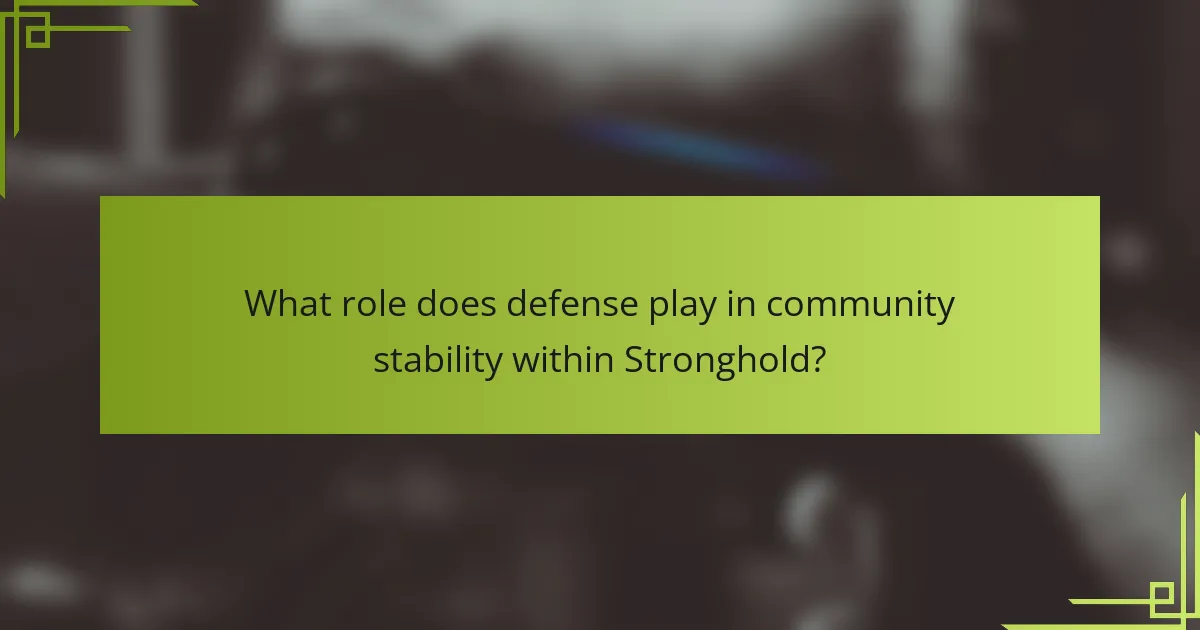
What role does defense play in community stability within Stronghold?
Defense plays a crucial role in maintaining community stability within Stronghold. It safeguards resources, enhances collaboration, and fosters resilience against external threats. A well-defended community can effectively manage resources and support its members, leading to sustained growth and cohesion. Moreover, strong defense mechanisms encourage members to engage in cooperative strategies, reinforcing social bonds. This synergy between defense and resource management creates a stable environment, ensuring the community can thrive despite challenges.
How can communities assess their defense needs?
Communities can assess their defense needs by conducting a thorough evaluation of resources and vulnerabilities. Start by identifying key assets, including infrastructure and personnel. Next, analyze potential threats through community surveys or expert consultations. Additionally, prioritize defense strategies based on available resources and specific community needs. Regularly updating this assessment ensures preparedness against evolving risks.
What are effective defensive strategies for resource protection?
Effective defensive strategies for resource protection include community collaboration, strategic resource allocation, and proactive risk assessment. Building strong community ties enhances collective security and resource sharing. Establishing clear roles and responsibilities ensures efficient management of resources. Regularly assessing potential threats allows for timely adjustments to defense strategies.
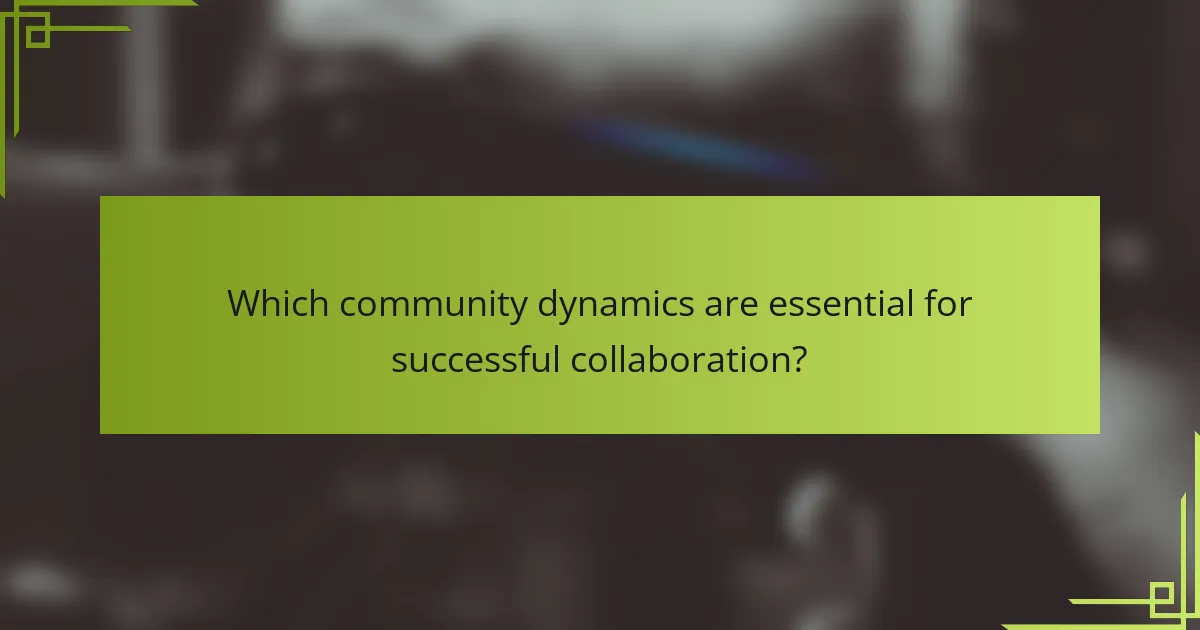
Which community dynamics are essential for successful collaboration?
Successful collaboration in community dynamics relies on trust, communication, and shared goals. Trust fosters a safe environment for members to express ideas. Effective communication ensures clarity and alignment on objectives. Shared goals unite members, driving collective action and resource management. These dynamics create a resilient community capable of defending against challenges and optimizing resource use.
How do leadership styles impact community engagement?
Leadership styles significantly influence community engagement by shaping trust, collaboration, and participation levels. For instance, transformational leaders inspire community members through vision and motivation, fostering a sense of belonging. In contrast, authoritarian leaders may stifle engagement due to a lack of inclusivity.
Communities with participative leadership often see higher engagement rates, as these leaders encourage input and feedback. Effective resource management is crucial, as it enables leaders to allocate community resources efficiently, enhancing overall participation.
Moreover, adaptive leadership styles, which respond to community needs, can lead to innovative solutions and stronger connections. Ultimately, the right leadership style can transform community dynamics, promoting resilience and collective action.
What communication methods foster collaboration among community members?
Effective communication methods that foster collaboration among community members include regular meetings, digital platforms, and feedback mechanisms. These methods encourage sharing ideas, coordinating efforts, and addressing concerns.
Regular meetings, whether in-person or virtual, create opportunities for members to discuss community goals and progress. Digital platforms, such as forums and social media, enable ongoing dialogue and resource sharing. Feedback mechanisms, like surveys, allow members to voice opinions and influence community decisions.
Utilizing multiple communication methods enhances engagement and strengthens community ties. This diverse approach supports a collaborative environment where all members feel valued.
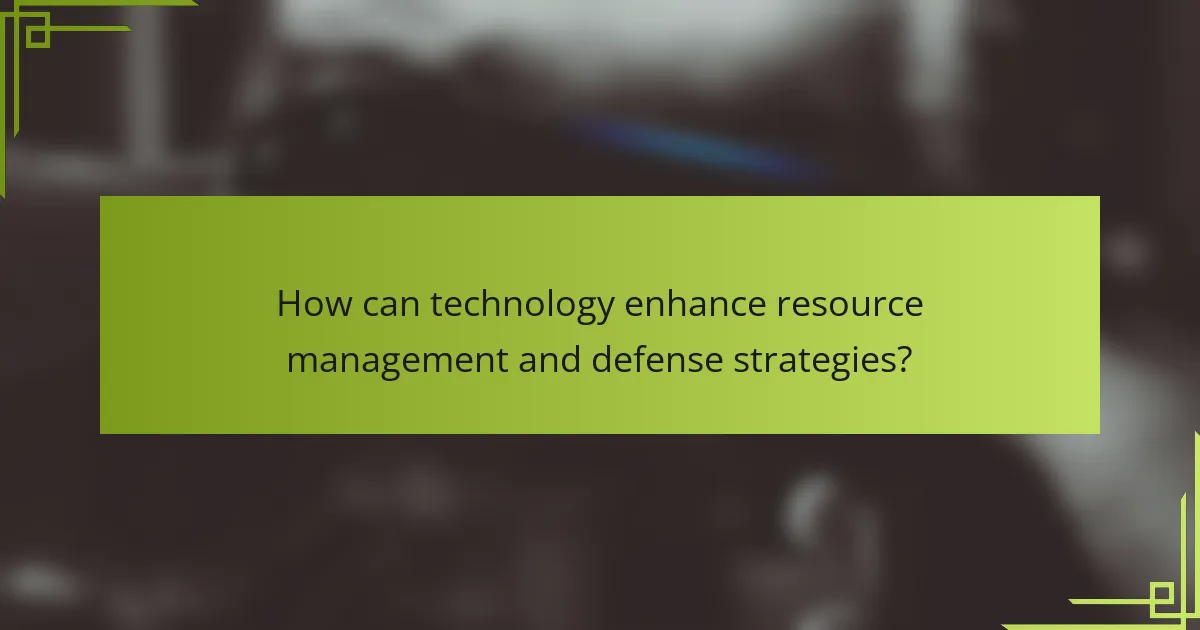
How can technology enhance resource management and defense strategies?
Technology enhances resource management and defense strategies by improving efficiency, coordination, and decision-making. Advanced software tools enable real-time tracking of resources, facilitating better allocation and utilization. For instance, data analytics can predict resource needs, allowing proactive measures to mitigate shortages. Additionally, technology fosters community engagement through platforms that streamline communication and collaboration among stakeholders. This collective effort strengthens defense strategies by ensuring a well-informed and responsive community. The integration of technology in these areas promotes sustainable practices and resilience against challenges.
Which tools are most effective for tracking resources?
Effective tools for tracking resources in “Stronghold: Community Building Through Resource Management and Defense” include resource management software, spreadsheets, and game-specific tracking apps. These tools help players monitor resource allocation, production rates, and inventory levels efficiently.
Resource management software offers comprehensive analytics and reporting features. Spreadsheets provide customizable tracking options, allowing users to create tailored resource management systems. Game-specific tracking apps often include features designed to enhance gameplay experience by integrating with in-game metrics.
Using these tools can significantly improve strategic planning and decision-making in resource management.
How can digital platforms improve community coordination and defense planning?
Digital platforms enhance community coordination and defense planning by facilitating communication, resource sharing, and strategic collaboration. They enable real-time information exchange, allowing communities to respond swiftly to threats. Platforms can integrate mapping tools for visualizing resources and vulnerabilities, improving situational awareness. Additionally, data analytics can identify trends and optimize resource allocation, ensuring effective defense strategies. Engaging community members through these platforms fosters a collective sense of responsibility and enhances overall preparedness.
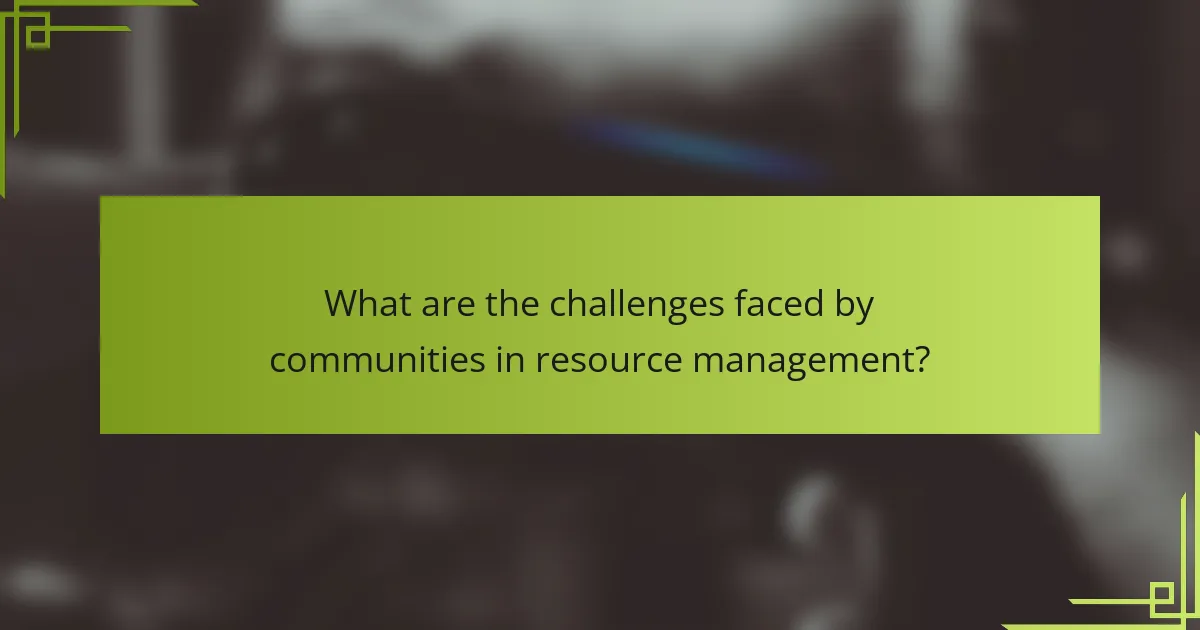
What are the challenges faced by communities in resource management?
Communities face several challenges in resource management, including limited access to resources, lack of infrastructure, and insufficient community engagement. These issues hinder effective planning and sustainable practices.
Limited access to resources often results from economic disparities and geographic isolation. Communities may struggle to secure essential supplies, leading to conflicts over resource allocation.
Lack of infrastructure can impede resource distribution and management efforts. Poor transportation and communication networks make it difficult for communities to implement effective strategies.
Insufficient community engagement can result in a lack of collective action. When community members do not participate in decision-making, resource management efforts may fail to address their specific needs.
How do external factors influence resource availability?
External factors significantly impact resource availability in community building. These factors include environmental conditions, economic stability, and social dynamics. For instance, natural disasters can disrupt supply chains, reducing access to essential resources. Economic fluctuations can affect funding for community projects, limiting resource allocation. Additionally, social cohesion influences resource sharing and collaboration among community members. Understanding these influences helps in developing effective resource management strategies for stronger community defense and support.
What common pitfalls should communities avoid in defense planning?
Communities should avoid common pitfalls such as lack of communication, insufficient resource allocation, and neglecting community engagement. These mistakes can undermine defense planning efforts and weaken collective resilience.
1. Lack of communication can lead to misunderstandings and misalignment of goals.
2. Insufficient resource allocation may result in inadequate preparedness against threats.
3. Neglecting community engagement diminishes trust and participation in defense initiatives.
4. Failing to assess risks regularly can leave communities vulnerable to emerging challenges.
5. Overlooking the importance of training can hinder effective response during crises.
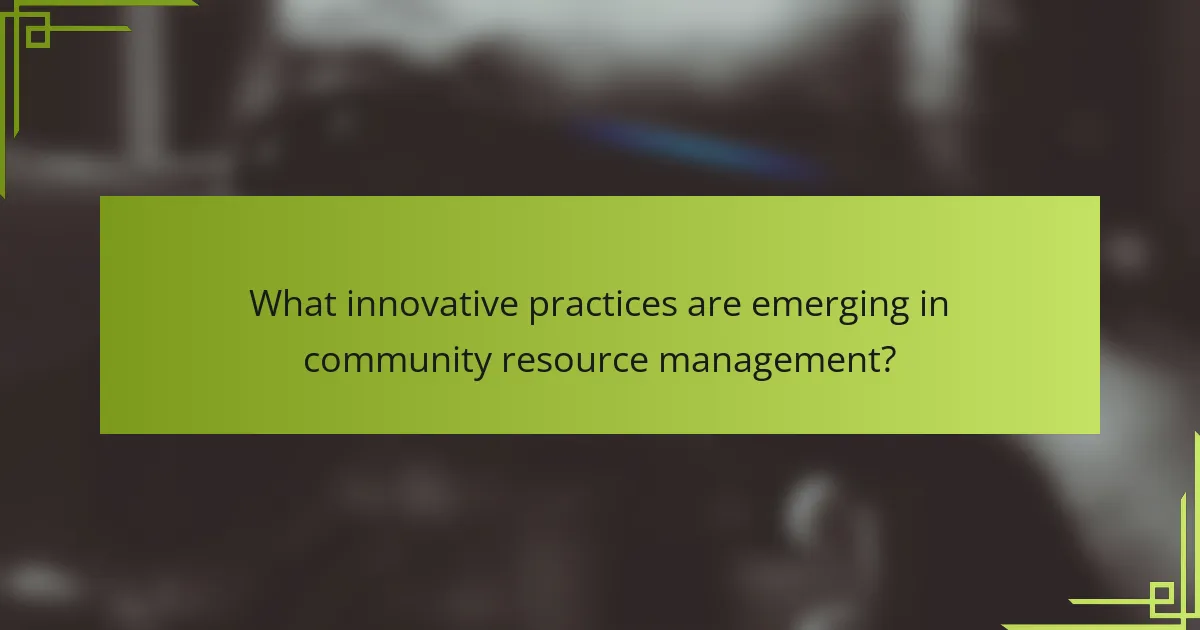
What innovative practices are emerging in community resource management?
Innovative practices in community resource management focus on collaboration and sustainability. Communities are adopting participatory approaches, enabling residents to engage in decision-making. This empowers individuals and fosters a sense of ownership.
Technology plays a crucial role in these practices. Digital platforms facilitate resource sharing, enhancing accessibility and efficiency. For example, community apps help track resources and connect users with local services.
Additionally, resilience planning is gaining traction. Communities are developing strategies to withstand environmental and economic challenges. This proactive approach ensures long-term sustainability and resource security.
Lastly, education and training initiatives are emerging. Workshops and programs equip community members with skills to manage resources effectively. This knowledge-sharing builds capacity and strengthens community ties.
How are communities adapting to changing environmental conditions?
Communities are adapting to changing environmental conditions by enhancing resource management and strengthening defense strategies. These adaptations involve collaborative efforts to optimize sustainable practices and build resilience against climate impacts.
For instance, communities are implementing innovative water conservation techniques, such as rainwater harvesting and greywater recycling. Additionally, local food systems are being prioritized to reduce reliance on external supply chains, which enhances food security.
Moreover, community engagement in environmental education fosters awareness and proactive measures. This includes workshops on sustainable agriculture and disaster preparedness, which empower residents to respond effectively to environmental changes.
Lastly, the establishment of community-led initiatives, such as tree planting and habitat restoration, not only improves local ecosystems but also strengthens social bonds, promoting a unified response to environmental challenges.
Which case studies exemplify successful community resource strategies?
Stronghold exemplifies successful community resource strategies through effective management and defense of shared assets. Key case studies include community gardens that promote food security, cooperative housing initiatives that enhance social ties, and local resource sharing platforms that reduce waste. Each case illustrates the impact of collaborative efforts on community resilience and sustainability.
What lessons can be learned from unique community initiatives?
Unique community initiatives teach valuable lessons in collaboration, resource management, and resilience. Stronghold exemplifies how communities can unite to effectively manage resources while defending against challenges.
These initiatives highlight the importance of shared goals, fostering trust, and enhancing social bonds. They demonstrate that collective action leads to improved outcomes, such as increased resource efficiency and stronger community ties.
Moreover, unique attributes like adaptability and innovation emerge as communities face diverse challenges. As a result, these initiatives encourage creative problem-solving and empower individuals to contribute meaningfully.
Finally, the rare trait of sustainability in resource management sets successful initiatives apart. Communities that prioritize long-term solutions build resilience, ensuring their growth and stability in the face of future challenges.

How can communities optimize their resource management and defense practices?
Communities can optimize resource management and defense practices through strategic planning and collaboration. Effective resource allocation enhances sustainability and resilience against threats.
First, conduct an assessment of available resources, identifying strengths and weaknesses. This evaluation informs prioritization of resource distribution. Next, establish clear communication channels to facilitate cooperation among community members. Regular meetings and updates promote transparency and collective decision-making.
Incorporate technology to track resource usage and needs. Tools like data management systems can streamline operations and improve efficiency. Finally, implement training programs to educate community members on best practices in resource management and defense strategies. This empowers individuals to contribute actively to community resilience.
What best practices should communities implement for long-term success?
Communities should focus on resource management, collaboration, and adaptive strategies for long-term success. Effective practices include:
1. Establishing clear communication channels to foster collaboration among members.
2. Implementing resource-sharing systems to maximize efficiency and reduce waste.
3. Encouraging community engagement through regular events and feedback mechanisms.
4. Adapting to changing needs by assessing community dynamics and resources periodically.
5. Building partnerships with local organizations to enhance support and resource availability.
Which expert tips can enhance community resilience and cohesion?
Expert tips to enhance community resilience and cohesion include fostering collaboration, promoting resource sharing, and developing local leadership. Engaging community members in decision-making strengthens bonds and encourages shared responsibility. Establishing networks for communication enhances trust and facilitates quick responses to challenges. Regular training and workshops can build skills for conflict resolution and emergency preparedness, ensuring communities can adapt and thrive.
What common mistakes hinder effective resource management and defense?
Common mistakes that hinder effective resource management and defense include poor planning, lack of communication, and inadequate training. These issues lead to inefficient use of resources and vulnerabilities in community defense.
Poor planning results in misallocation of resources, which can leave critical areas exposed. Lack of communication among team members can create confusion and delays in response to threats. Inadequate training prevents individuals from effectively utilizing available resources, reducing overall community resilience.
Addressing these mistakes involves establishing clear strategies, fostering open communication, and investing in training programs. By doing so, communities can enhance their resource management and defense capabilities.